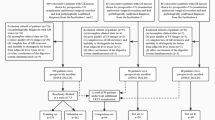Abstract
Purpose
To develop and validate a novel method based on radiomics for the preoperative differentiation of benign and malignant gallbladder polypoid lesions (PLG).
Patients and methods
A total of 145 patients with pathological proven gallbladder polypoid lesions ≥ 1 cm were included in this retrospective study. All the patients underwent abdominal contrast-enhanced computed tomography (CT) examinations 3 weeks before cholecystectomy from January 2013 to January 2019. Seventy percent of the cases were randomly selected for the training dataset, and 30% of the cases were independently used for testing. Radiomics features extracted from portal venous-phase CT of the PLG and clinical features were analyzed, and the LASSO regression algorithm was used for data dimension reduction. Multivariable logistic regression was used to generate radiomics signatures, clinical signatures, and combination signatures. The receiver operating characteristic (ROC) curve and decision curve were plotted to assess the differentiating performance of the three signatures.
Results
The area under the ROC curve (AUC) of the radiomics signature and clinical signature was 0.924 and 0.861 in the testing dataset, respectively. For the radiomics signature, the accuracy was 88.6%, with 88.0% specificity and 89.5% sensitivity. When combined, the AUC was 0.931, the specificity was 84.0%, and the sensitivity was 89.5%. The differences between the AUC values of the two sole models and the combination model were statistically nonsignificant.
Conclusion
Radiomics based on CT images can be helpful to differentiate benign and malignant gallbladder polyps ≥ 1 cm in size.






Similar content being viewed by others
Data availability
All authors have reviewed the final version of the paper and would like to take public responsibility for its content. The authors declare that they had full access to all of the data in this study and the authors take complete responsibility for the integrity of the data and the accuracy of the data analysis.
Abbreviations
- 3D:
-
Three-dimensional
- AUC:
-
Area under the curve
- CI:
-
Confidence interval
- CT:
-
Computed tomography
- DICOM:
-
Digital Imaging and Communications in Medicine
- PLG:
-
Gallbladder polypoid lesions
- ROC:
-
Receiver operating characteristic
- ROI:
-
Region of interests
References
Park CH, Chung MJ, Oh TG et al. Differential diagnosis between gallbladder adenomas and cholesterol polyps on contrast-enhanced harmonic endoscopic ultrasonography. Surgical endoscopy 2013;27:1414-21.
Lee KF, Wong J, Li JC, Lai PB. Polypoid lesions of the gallbladder. American journal of surgery 2004;188:186-90.
Kim SW, Kim HC, Yang DM, Ryu JK, Won KY. Gallbladder carcinoma: causes of misdiagnosis at CT. Clinical radiology 2016;71:e96-109.
Ogawa T, Horaguchi J, Fujita N et al. High b-value diffusion-weighted magnetic resonance imaging for gallbladder lesions: differentiation between benignity and malignancy. Journal of gastroenterology 2012;47:1352-60.
Zhou W, Li G, Ren L. Triphasic Dynamic Contrast-Enhanced Computed Tomography in the Differentiation of Benign and Malignant Gallbladder Polypoid Lesions. Journal of the American College of Surgeons 2017;225:243-248.
Zielinski MD, Atwell TD, Davis PW, Kendrick ML, Que FG. Comparison of surgically resected polypoid lesions of the gallbladder to their pre-operative ultrasound characteristics. Journal of gastrointestinal surgery : official journal of the Society for Surgery of the Alimentary Tract 2009;13:19-25.
van Timmeren JE, Leijenaar RTH, van Elmpt W et al. Survival prediction of non-small cell lung cancer patients using radiomics analyses of cone-beam CT images. Radiotherapy and oncology : journal of the European Society for Therapeutic Radiology and Oncology 2017;123:363-369.
Kim J, Choi SJ, Lee SH, Lee HY, Park H. Predicting Survival Using Pretreatment CT for Patients With Hepatocellular Carcinoma Treated With Transarterial Chemoembolization: Comparison of Models Using Radiomics. AJR American journal of roentgenology 2018;211:1026-1034.
Yang L, Dong D, Fang M et al. Can CT-based radiomics signature predict KRAS/NRAS/BRAF mutations in colorectal cancer? European radiology 2018;28:2058-2067.
Giraud P, Giraud P, Gasnier A et al. Radiomics and Machine Learning for Radiotherapy in Head and Neck Cancers. Frontiers in oncology 2019;9:174.
Larue R, van Timmeren JE, de Jong EEC et al. Influence of gray level discretization on radiomic feature stability for different CT scanners, tube currents and slice thicknesses: a comprehensive phantom study. Acta oncologica (Stockholm, Sweden) 2017;56:1544-1553.
Park JY, Hong SP, Kim YJ et al. Long-term follow up of gallbladder polyps. Journal of gastroenterology and hepatology 2009;24:219-22.
Park JK, Yoon YB, Kim YT et al. Management strategies for gallbladder polyps: is it possible to predict malignant gallbladder polyps? Gut and liver 2008;2:88-94.
Miwa H, Numata K, Sugimori K et al. Differential diagnosis of gallbladder polypoid lesions using contrast-enhanced ultrasound. Abdominal radiology (New York) 2019;44:1367-1378.
Choi JH, Seo DW, Choi JH et al. Utility of contrast-enhanced harmonic EUS in the diagnosis of malignant gallbladder polyps (with videos). Gastrointestinal endoscopy 2013;78:484-93.
Irie H, Kamochi N, Nojiri J, Egashira Y, Sasaguri K, Kudo S. High b-value diffusion-weighted MRI in differentiation between benign and malignant polypoid gallbladder lesions. Acta radiologica (Stockholm, Sweden : 1987) 2011;52:236-40.
Jang JY, Kim SW, Lee SE et al. Differential diagnostic and staging accuracies of high resolution ultrasonography, endoscopic ultrasonography, and multidetector computed tomography for gallbladder polypoid lesions and gallbladder cancer. Annals of surgery 2009;250:943-9.
Funding
No funding.
Author information
Authors and Affiliations
Contributions
Xu and Niu contributed to the study design. Yang, Liu, and Chai carried out the collection and assembly of data and drafted the manuscript. Guo did the feature extraction statistical work. All authors reviewed the manuscript. All authors read and approved the final manuscript.
Corresponding author
Ethics declarations
Conflict of interest
The authors declare that they have no competing interests.
Ethics approval
Ethical approval was obtained for this retrospective analysis, and the informed consent requirement was waved.
Informed consent
Not applicable.
Additional information
Publisher's Note
Springer Nature remains neutral with regard to jurisdictional claims in published maps and institutional affiliations.
Rights and permissions
About this article
Cite this article
Yang, X., Liu, Y., Guo, Y. et al. Utility of radiomics based on contrast-enhanced CT and clinical data in the differentiation of benign and malignant gallbladder polypoid lesions. Abdom Radiol 45, 2449–2458 (2020). https://doi.org/10.1007/s00261-020-02461-2
Published:
Issue Date:
DOI: https://doi.org/10.1007/s00261-020-02461-2




